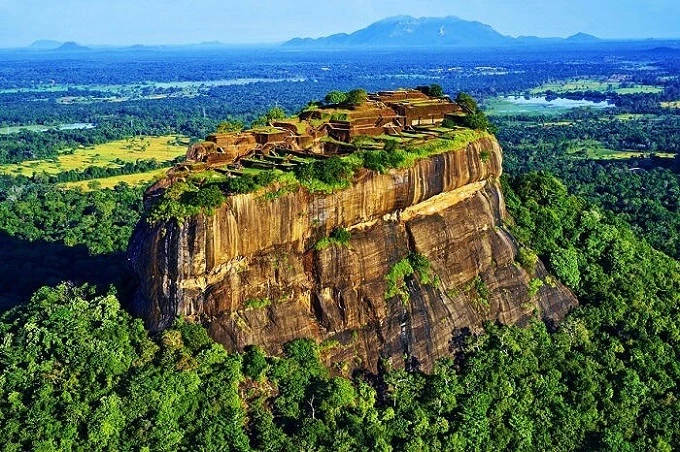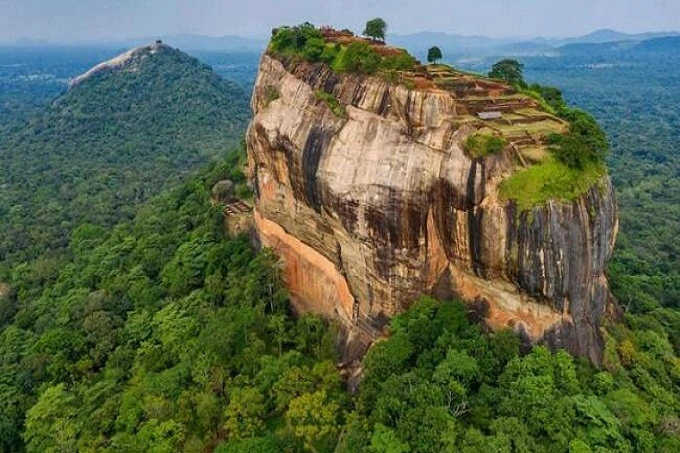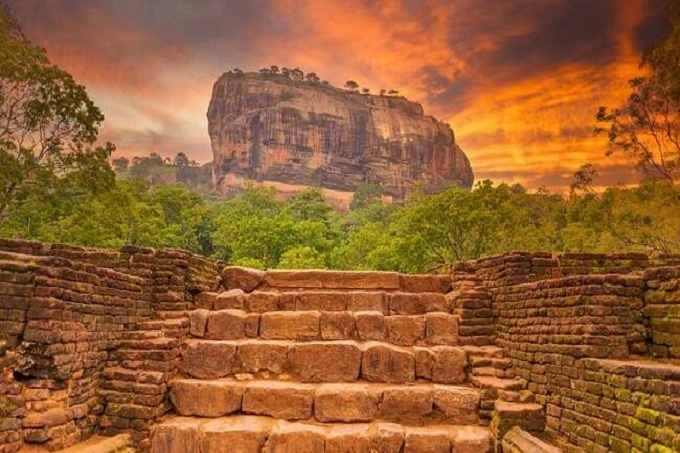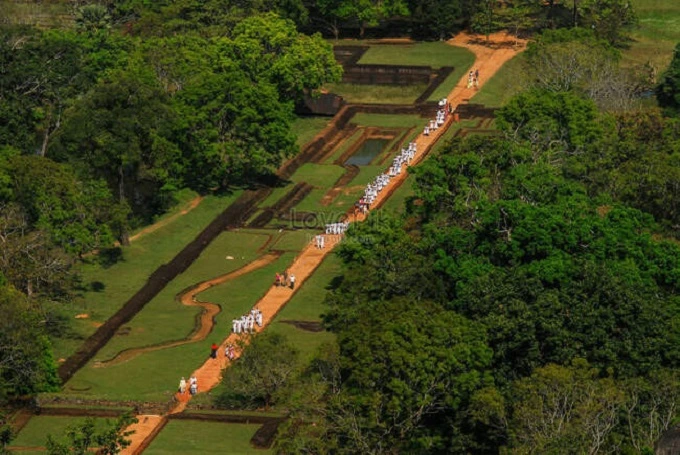Sigiriya: what mysteries does the ancient city-fortress keep

Sigiriya, an ancient city located among the clouds on top of a lonely rock, is one of Sri Lanka’s most well-known attractions, along with the country’s seemingly endless tea plantations, ancient cities, and castles. It is the most important archaeological asset on the entire planet because everything associated with its organization can be considered to be the very best, beginning with urban planning and landscape design and ending with the largest picture in the world and a one-of-a-kind irrigation system that was many centuries ahead of its time. This is why it is the most important archaeological asset.
The history of the appearance of Sigiriya

Sigiriya, an ancient walled city, located on a rocky cliff and proudly rising among the fragrant greenery of forests, is one of the most striking sights in Sri Lanka, attracting the attention of millions of tourists and researchers each year. Its history began a very long time before the year 477. On a massive monolith that was 370 meters above sea level and 170 meters above the plain that surrounded it, the construction of a fortress city that was exceptional in every way commenced.
It is believed that the first people to appear on the plateau, proudly rising above the forest, appeared in the 5th century BC. These people were Buddhist monks who founded a cave monastery in one of the natural caverns on the plateau. Today, the plateau is home to many natural caves, despite the fact that people began settling in this area much earlier. However, the construction of the fortified city did not start until 1000 years later, in the 5th century AD. This was during a time when the illegitimate son of King Kasap had taken power by force and was hiding from the rightful heir (younger brother). Kasap decided to found a new capital city. According to the urban legend, he gave the order to construct an astonishingly beautiful city surrounded by moats filled with water and raised to a considerable height with the assistance of innovative hydraulic equipment. As a result, he wanted to place emphasis on his authority and power.
Construction of a new capital

Over time, structures such as fortified ditches and ramparts, a citadel, and other fortifications were built around the rock and on the top of the plateau. On the top of the plateau, there was also a lavish royal palace and more modest mansions for the nobility at the foot of the cliff. Gardens were also laid out with fountains, pools, streams, and platforms with pavilions for performances. These gardens are rightfully considered the first example of landscape design anywhere in the world. Because no other ancient fountains have been found to date, it is possible to refer to them as the oldest hydraulic structures on the planet, in addition to the organization of the city itself, which featured a deft mix of symmetrical and asymmetrical elements, including secular buildings and fortifications, streets and squares, pools, gardens, and terraces. According to the researchers’ findings, Sigiriya is the most illustrative example of the ancient urban planning of South Asia.
Lion rock

The royal palace and its preserved water gardens are one of the most popular tourist destinations in Sri Lanka and for a good reason. Modern visitors can enter the palace and gardens through a gate called the Lion Gate. In the beginning, on both sides of the stairs that led to the upper level, strong stone paws with claws were installed, and on top of it, a giant head was installed, but it fell over the course of time. They are not just called that for no reason. There is no evidence that the statue originally depicted a lion; however, legends claim it was still the king of beasts, which is the description that most effectively highlights the king’s greatness. Although many tourists believe that they are the paws of incredibly huge tortoises, they may belong to some mythical creature guarding the entrances to the palace.
Main attractions of Sri Lanka

The luxury royal palace was constructed on the plateau’s highest point, and the most beautiful gardens surrounded it. However, only members of the royal family were permitted to enter these gardens. According to the documentary sources that have been preserved, the palace was replete with lavish amenities; in fact, the exterior of the palace was richly decorated with gold and precious stones. Because the residence was only used for its intended purpose for a very brief period, it was impossible for any gold or other riches to have been preserved since that time. Kasapa maintained control of the country for twenty years until the legitimate heir amassed an army and took the throne. Following the victory, the brother who ascended to power issued an order to remove all of the jewels and demolish the palace. The surviving structures were then given to Buddhist monks so that they could establish a monastery.
Despite the fact that one and a half thousand years have passed and that for half of those years, the palace complex was in complete disrepair, some elements have survived. These include porcelain wall coverings with poems and poems carved on them that are dedicated to female beauty, a gallery of frescoes, among which a unique painting of the size 140 by 40 meters, located in the hall of mirrors, or rather in what was left of it, stone elements of decoration, including the throne of the
The sweeping strokes, with a lot of pressure on one side of the brush, were a distinguishing characteristic of the style of writing frescoes. These strokes made it possible to create drawings with more volume than the drawing technique used during the Anuradhapura period when the frescoes were created.
Only 18 frescoes have survived to this day; they depict naked concubines and dancers of the king, with whom he loved to spend his leisure time. Although according to some sources, the celestial maidens on the frescoes of Sigiriya (initially, about 500 of them) were not concubines but the goddess Tara. She was portrayed in the image of different girls, and not only her face could differ, but also the color of her skin: white, blue, red, green or yellow, which is the main confirmation of the highest manifestations of the deity.
Terraced gardens and the wonder of an ancient irrigation system
It is not so much the architectural objects and the luxurious decoration of the palace complex that cause admiration; rather, the greatest surprise was the organization of a network of hydraulic structures that provided water for both pools with fountains and irrigation of luxurious gardens. This network of hydraulic structures became a key element in the organization of the palace, park complex, and fortress city. They are the oldest in the world, and the engineering ingenuity with which they were constructed is also astonishing.
It is worth mentioning right away that three types of gardens were created in the city: water, terraced and stone. The most attractive are terraced gardens, formed with retaining walls built of stone. They rise above the other and go around the mountain in asymmetric concentric circles, connected by boulders and spectacular stone stairs. Presumably, the terraced gardens located on the lower level were used for growing vegetables and fruits. At the same time, the upper tiers were intended for decorative plantings to please the eye of the king.

Water gardens were no less impressive, but they had a symmetrical shape and required special knowledge of the intricacies of engineering and physics so that you could not only fill them with water but also ensure its constant renewal since water bodies performed essential functions: cooling the surrounding space and using pools for hygienic and household needs.
According to legend, water came to these gardens from a natural lake on top of a cliff. Still, it had to be raised to a considerable height, using a system of cunning hydraulic structures and special equipment to force the water to violate all the laws of gravity. Water entered the palace and park complex from a nearby reservoir, from which an underground network of clay pipes was laid, dams, water wheels, dampers in the right places, ditches and canals were installed, connecting additional reservoirs and underground cisterns. Thanks to artificially created hydraulic pressure, water flowed into pools and streams and created fountains that are still active today (especially during the rainy monsoon season). By the same principle, only exactly the opposite (with the exception of the water wheel).
The modern history of Sigiriya

Evidence suggests that Buddhist monks resided on the land that comprised the former kingdom up until the 14th century. After this time, the only stories told about them were legends. Especially vivid tales have been passed down about the magnificent palace, which is said to have been home to untold riches. For many centuries, people believed that the Sigiriya Palace had been utterly demolished and that the surrounding jungle had absorbed it for all time.
However, in 1831, the ruins and the frescoes were found accidentally. From that point on, active research work began, which made it possible to clean up the remains of the palace, as well as the fortifications and the beautiful gardens. Sigiriya was added to the UNESCO World Heritage List in 1982 as a result of the efforts of enthusiasts. This inclusion contributed to the acceleration of the restoration process and the organization of tourist routes, both of which attracted millions of people interested in ancient history.
It is easy to guess that not everyone will be able to go on an excursion, particularly to the royal palace, given that the historical monument of architecture is located on a high mountain. This is a reasonable assumption to make, given the location of the monument. To conquer the well-known Lion Stairs, you will need to walk more than 1,200 unstable and potentially dangerous steps, which, combined with the oppressive heat, is not at all an easy task (and this is not counting the foot). Those who want to see the ruins of a one-of-a-kind city with their own eyes should go on an excursion a couple of hours before dawn wearing appropriate clothes and shoes, remember to bring water, and spend at least a few dollars on a ticket to enter such an amazing place.




